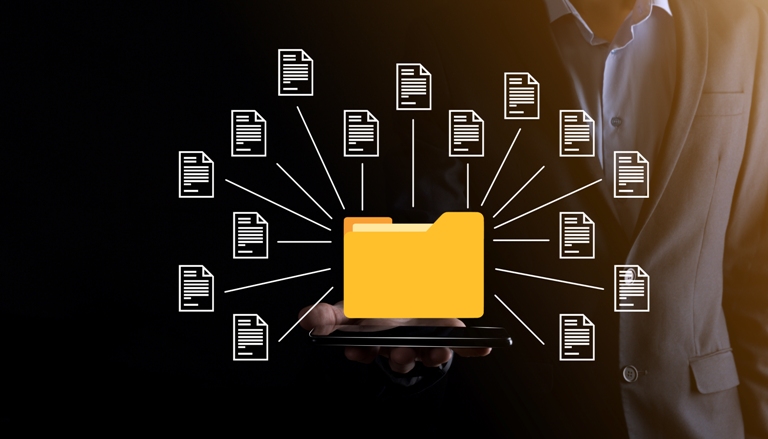
Organizations generate incredible amounts of digital data—historical records, research findings, legal documents—but this information is greatly at risk without a structured approach to digital preservation. As organizations strive to adapt to increasingly complex environments, the need for a comprehensive Digital Document Management System (DMS) has never been greater.
How Do You Choose an Electronic Document Management System?
Choosing the right EDMS is a crucial decision for any accounting or CPA firm. The first step is to decide which type of EDMS best suits your firm’s operations. Here’s a quick look into the three main types of EDMS:
- Server-based systems – These are always hosted and managed on a firm’s internal servers. They offer complete control over data but typically require considerable upfront investments in the hardware and ongoing IT support.
- Cloud-based systems – Increasingly popular, these systems store the data on remote servers managed by any service provider. They offer great flexibility, ease of use, and lesser startup costs, making them perfect for smaller or the growing firms.
- Web-based systems – Think of these systems as a hybrid between the server- and cloud-based systems. They might still involve the server infrastructure but are accessed through a high web interface.
Tip: Small or growing accounting firms often prefer cloud-based solutions due to their scalability and lower costs.
Key Components a Digital Document Management System Must Offer
Here’s what a modern DMS must offer to meet these expectations:
1. Document indexing and scanning:
Effective document indexing and scanning are the basic features of a modern Document Management System (DMS), ensuring that all documents are systematically organized and also easily retrievable. Through indexing, each document is tagged with key metadata like titles, dates, keywords, authors, and categories—that facilitate the quick location of specific files or information fragments, even in large databases. Scanning capabilities digitize physical documents, converting them into searchable formats that integrate smoothly into digital workflows. Together, indexing and scanning eliminate the clutter of the physical paperwork and decrease the time employees spend looking for data empowering teams with immediate access to the information they need to work effectively.
2. File management and collaboration:
Enabling teams to work together on documents seamlessly allows them to collaborate without the need for costly software licenses, such as Microsoft Office. By incorporating built-in tools for working with popular file formats—such as text documents, spreadsheets, presentations, and drawings—robust File Management shall remove the dependency on external applications.
3. Secure document storage:
Designed to protect the sensitive information while also making it accessible only to the authorized personnels. This involves a multi-layered approach that combines encryption, access controls, and auditing to secure the data at every stage. Encryption protects the documents both in transit and at rest, ensuring that unauthorized individuals cannot access or interpret any of the data. Granular access controls enable the administrators to define precise permissions, restricting access based on the diverse user roles, departments, or specific user needs so that only the designated individuals can view, edit, or share specific documents.
4. Document Workflow Automation with No-Code Capabilities:
A modern-day DMS should offer no-code workflow automation, empowering non-technical users to create a customized workflows, like approvals or e-signature requests, through an intuitive drag-and-drop interface. This boosts efficiency by minimizing the manual tasks and permitting different departments to streamline different processes without needing IT support.
5. E-Signature capabilities:
E-signature capabilities are a vital feature within Document Management Systems (DMS), particularly when seamlessly integrated with custom client workflows to create a swift, secure, and highly efficient approval process. This functionality enables users to electronically sign documents from any location, eliminating the necessity for the physical signatures and significantly cutting down the delays often associated with paper-based workflows. E-signatures meet strict regulatory standards, providing them the same legal validity as the traditional signatures while adding several security layers, including identity verification and audit trails to track each step of the signing process. By incorporating e-signature functionality, businesses can accelerate the contract approvals, streamline the workflow processes, and maintain fully digital, secure the records of signed documents.
6. Document Collaboration with Simultaneous Editing and Version Control:
Real-time collaboration is vital for today’s teams. A DMS must support simultaneous editing and version control, ensuring that diverse users can work on documents concurrently while tracking changes. This prevents errors and ensures transparency, permitting teams to access and revert to previous versions as needed.
7. Intelligent Document Search:
A DMS should feature intelligent full-text search, enabling users to locate specific fragments of data within documents quickly. This saves time and increases productivity by providing a rapid and precise search results.
8. Document Retention:
To ensure absolute compliance and optimize storage, a DMS should offer customizable document retention policies that permit flexible management. These policies automate the document lifecycle management, empowering businesses to securely retain or delete the files according to the regulatory requirements as well as internal policies, thereby cutting down storage costs and ensuring complete compliance with relevant regulations.
9. Robust Security Framework:
A modern DMS must incorporate a robust security framework to protect sensitive documents and restrict access to authorized users only. Essential security features include Multi-Factor Authentication (MFA), which adds a robust verification layer beyond just a simple password; Granular access rights management, which enables precise control over who can view, edit, or even share specific files, ensuring sensitive information remains accessible only to designated personnel; and Data Encryption to secure documents both at rest and in transit, safeguarding against unauthorized access. Besides, high availability ensures very continuous access to records through all the redundant systems and failover capabilities, decreasing the downtime and maintaining access even during the system disruptions.
10. Watermarks, Barcodes, and QR Codes for Security and Data Access:
To enhance document security, modern DMS platforms should incorporate the watermarks to prevent any kind of unauthorized sharing and also utilize barcodes or QR codes to link documents with extra metadata or information. These features improve both the security and document tracking.
11. A dynamic organizational structure and user profile management:
These capabilities should be based on the user roles and responsibilities, enabling tailored access and permissions aligned with every user’s position within the organization. Deputy functionality is also crucial, as it permits the designated substitutes to assume the duties during times of sick leave or vacation, ensuring that the workflows remain uninterrupted.
In Conclusion
The adoption of a digital document management system is much beyond than a strategic move to cut down the operating costs; it’s a commitment to embracing digital transformation and also fostering a forward-thinking organizational culture. A digital DMS not only streamlines the document management processes but also catalyzes the innovation, efficiency, and resilience.
Understanding how digital document management works is a good starting point for transitioning to a digital environment. However, it’s just one step in a holistic approach. Don’t wait until records become unreadable or lost. Get a FREE DEMO for SFT Dox today!










